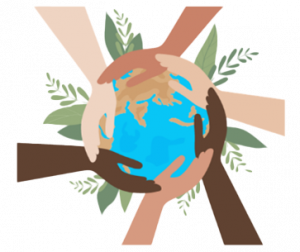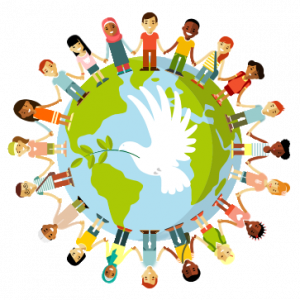
Immigration Litigation: Nationwide Injunctions
You may have seen recent headlines stating that executive actions have been blocked by a federal judge. For instance, on...
READ FULL STORY
By: Rosalind Ghafar Rogers, PhD, LMHC, Clinical Behavioral Health Subject Matter Expert
with USCRI’s Refugee Health Services in Arlington, VA
Societies are more diverse than ever, but intolerance is growing around the globe. Our world is currently steeped in conflict, oppression, violence, and war, all of which inflict incalculable suffering on innocent people. Sectarian tensions are at the heart of many of these conflicts, with a rise in violent extremism and massive human rights violations. We are facing the largest crisis of forced displacement since World War II – 108.4 million or 1 in 6 people worldwide – and this has triggered a rise in xenophobia and hatred against migrants, refugees, and other minority groups (UNHCR, 2023).
According to Gallup’s Migrant Acceptance Index, the world has become less tolerant of migrants, refugees, and other minority groups than it was even three years ago (Esipova et al., 2020). In Europe, public opinion polls show a rising fear and aversion to Muslims, who are seen as a threat to national identity, social cohesion, and domestic security (Esipova et al., 2020). Research in Australia found that 22% of refugees and asylum-seekers experienced discrimination, with a higher rate of discrimination reported by those from the Middle East and Africa (Ziersch et al., 2020). Based on research from the Anti-Defamation League (ADL, 2023), in 2023, 38% of Muslims and 26% of Jewish people in the U.S. experienced harassment.
Intolerance is very often rooted in ignorance and fear: fear of the unknown and fear of the other – other cultures, ethnicities, nations, languages, religions, and beliefs. It often leads to injustice and inequality and may lead to the dehumanization of a group of people. Intolerance has many forms, including prejudice, stereotypes, racism, xenophobia, anti-immigrant sentiments, antisemitism, Islamophobia, sexism, or religious intolerance. Intolerance can manifest as discrimination, harassment, human rights violations, oppression, marginalization, segregation, scapegoating, hate-speech, hate-crimes, or violence.
Intolerance in a society is the sum-total of the intolerance of its individual members. Therefore, intolerance breeds intolerance. Factors that contribute to intolerance range from individual to governmental and institutional:
 ethnic, national, cultural, and religious backgrounds.
ethnic, national, cultural, and religious backgrounds.
Research has consistently shown that one of the major stressors that affect the health and successful integration of migrants and refugees is intolerance in the form of discrimination, racism, and xenophobia. Discrimination, along with other forms of social disadvantage, has negative effects on migrants’ and
refugees’ health and contributes to existing health disparities. At the societal level, discrimination operates through residential segregation and unequal access to safe housing, jobs, education, healthcare, and social services due to migrants’ and refugees’ foreign-born status, ethnic origin, or race. At the individual level, discrimination is an acute and chronic stressor that activates physiological responses, such as increased blood pressure, heart rate, and hormone production, that lead to poorer mental and physical health among refugees (Szaflarski & Bauldry, 2019).
Perceived discrimination has been associated with a wide range of health behaviors and outcomes, including obesity, hypertension, substance abuse, depression, anxiety, posttraumatic stress disorder (PTSD), and severe mental illness among migrants and refugees (Chen et al., 2017; Szaflarski & Bauldry, 2019). Discrimination has also been associated with less sense of belonging, lower levels of trust, reduced sense of control, and less hope, all of which negatively impact refugees’ successful integration and sense of safety in host countries (Ziersch et al., 2020). Over time, the dehumanizing effects of discrimination, xenophobia, and anti-immigrant sentiments against migrants and refugees can lead to symptoms of trauma, alienation, and chronic stress.
Fighting intolerance requires developing and practicing tolerance and acceptance. According to UNESCO’s Declaration of Principles on Tolerance (1995), tolerance is “respect, acceptance and appreciation of the rich diversity of our world’s cultures, our forms of expression and ways of being human.” Other aspects of tolerance include:

In a world of increasing diversity, growing divisions, and escalating violence, intolerance is a global threat. As we observe the International Day for Tolerance, we must commit to cultivating tolerance, acceptance, and understanding in ourselves and others through our actions. We must commit to protecting and defending the most vulnerable among us and challenging ourselves and others to speak up when we witness intolerance or injustice. As we recognize this day, and practice every day, we must work collectively and in solidarity towards embracing our common humanity and promoting a culture of peace that our world so desperately needs.
References
ADL. (2023). Online Hate and Harassment: The American Experience 2023. Retrieved from https://www.adl.org/resources/report/online-hate-and-harassment-american-experience-2023
Chen W., Hall, B. J., Ling, L., & Renzaho, A. M. (2017). Pre-migration and post-migration factors associated with mental health in humanitarian migrants in Australia and the moderation effect of post-migration stressors: findings from the first wave data of the BNLA cohort study. The Lancet Psychiatry, 4(3), 218–229.
Esipova, N., Ray, J., & Pugliese, A. (2020). World grown less accepting of migrants. Gallup. Retrieved from https://news.gallup.com/poll/320678/world-grows-less-accepting-migrants.aspx
Szaflarski, M. & Bauldry, S. (2019). The effects of perceived discrimination on immigrant and refugee physical and mental health. Advances in Medical Sociology, 19, 173-204. https://doi.org/10.1108/S1057-629020190000019009d
UNESCO. (1995). Declaration of Principles on Tolerance. Retrieved from https://www.unesco.org/en/legal-affairs/declaration-principles-tolerance?hub=66765
UNHCR. (2023). Global Trends: Forced Displacement in 2022. Retrieved from https://www.unhcr.org/global-trends-report-2022
UNHCR. (2002). Integration Handbook for Resettled Refugees. Retrieved from https://www.unhcr.org/handbooks/ih/welcoming-inclusive-societies
Ziersch, A., Due, C., & Walsh, M. (2020). Discrimination: a health hazard for people from refugee and asylum-seeking backgrounds resettled in Australia. BMC Public Health 20, 108. https://doi.org/10.1186/s12889-019-8068-3

You may have seen recent headlines stating that executive actions have been blocked by a federal judge. For instance, on...
READ FULL STORY
The U.S. Committee for Refugees and Immigrants (USCRI) voices grave concern over the most recent in a series of devastating...
READ FULL STORY
What does it mean to become a refugee before you’ve even had the chance to grow up? From Syria to...
READ FULL STORY